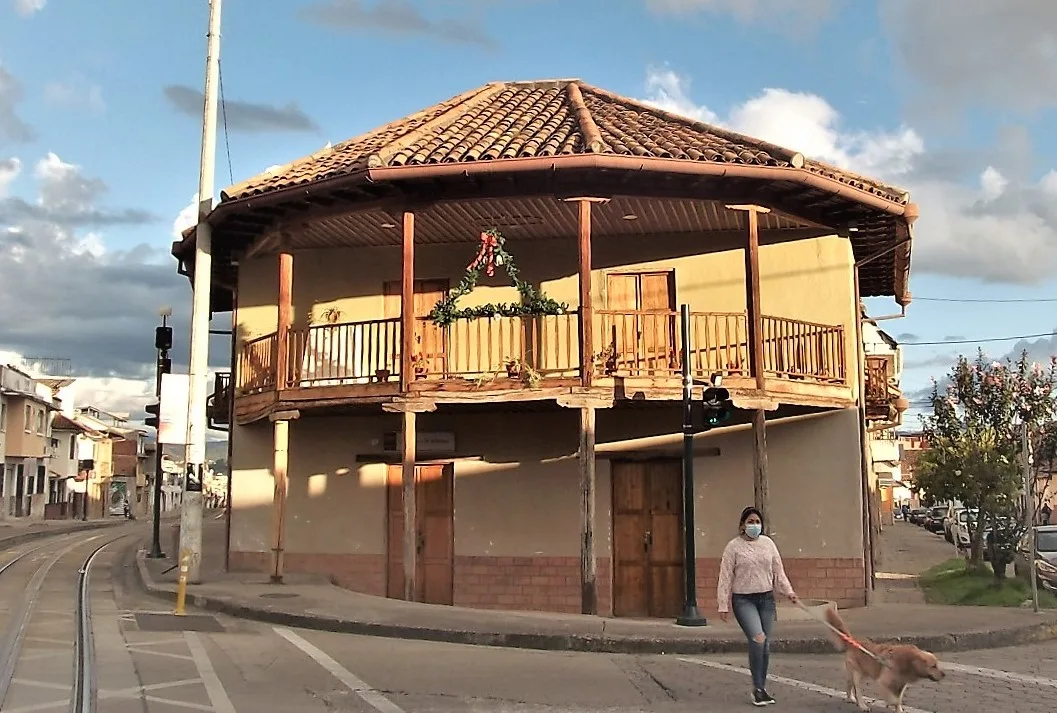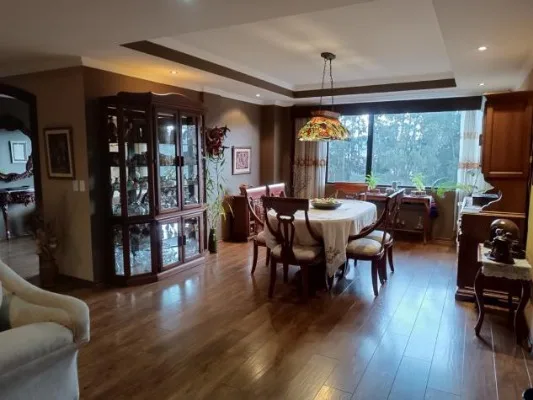Cuenca downpour: How an expat’s guitar lesson becomes a lesson in culture and the weather
By Jeremiah Reardon
It was an overcast Friday afternoon in Cuenca when I joined two other students in a guitar lesson taught by one of Ecuador’s finest practitioners of the art, Bolivar Sarmiento, at Casa del Alfarero Cultural Center. The charismatic instructor strolled into the center’s lobby in a casual outfit set off with a Panama hat (made in Ecuador, of course!). He is the perfect teacher for me, always encouraging me to progress, writing chords, scales and challenging exercises in my music notebook.
strolled into the center’s lobby in a casual outfit set off with a Panama hat (made in Ecuador, of course!). He is the perfect teacher for me, always encouraging me to progress, writing chords, scales and challenging exercises in my music notebook.

Casa del Alfarero Cultural Center, Calle Lamar y Convencion 45.
How I came to play resulted from crafting my own acoustic guitar in a workshop led by four San Bartolome craftsmen over six months. These instructors traveled an hour to our classes from their picturesque Andean hillside homes (think Sound of Music with a Spanish flavor), dotted along San Bartolo’s famed Ruta de La Guitarra.
With attendance at my nephew’s wedding in California on the horizon, I set out to play as a surprise a reworked verse of Hallelujah by Leonard Cohen, expressing how I felt upon learning the family news. By the time I had joined Bolivar’s music class I also had learned to play the harmony to a Peruvian folk song, El Condor Pasa, the melody for Simon and Garfunkel’s If I Could and the song which my fourth instructor, Osvaldo Landi, played to appraise a finished guitar.

Bolivar Sarmiento playing Noche de Paz on Jeremiah Reardon’s workshop guitar.
Toward the end of Bolivar’s two-hour class, over string-plucked arpeggios and strummed guitar chords, thunder rumbled. Hmm, sounds close, I thought. I looked upwards through the center’s skylight to see dark clouds.
When class was over, I went upstairs to the center’s gallery to revisit the show of acrylic paintings by my Cuban American friend, Eduardo Cervino. I admired many of his brilliantly executed paintings which interpreted extraterrestrial vistas. Far out colors and other-worldly shapes leaped from white-painted walls under a low-ceiling.
Eduardo’s tenacity for better opportunities as an educated young man led him to leave Cuba. After a few unsuccessful attempts by boat, he took a flight from Cuba for Madrid. Leaving by air was dramatic, saying, in a few hours, goodbye to his entire life, family, everything, while carrying only a small bag.
Mike Gruber worked with me at Baltimore’s public housing authority. At lunch or after a game of basketball with co-workers, he shared with me how his family lost their manufacturing company once the communists nationalized businesses. They, too, fled Cuba for the States. While these experiences may have hardened Eduardo and Mike’s outlook on reality, Eduardo maintains the same positive and friendly attitude which made me admire Mike.

Jeremiah Reardon playing Hallelujah at nephew’s Marshall, CA, wedding, May 2022.
With a heart lifted by Eduardo’s idiosyncratic art, I stepped outside the center. Threatening gray clouds to the north and west topped mountain peaks where Cajas National Park serves as a scenic backdrop to our Andean city. I followed tranvia tracks to the east as I had errands downtown. After walking a few blocks, large raindrops began to pelt my rain jacket. I kept close to a line of storefronts and homes. Their corbels and overhangs protected me from the rain. Once the rain fell in earnest, I surrendered and stood still. Backed up to the wall, I tried to keep my guitar dry. To pass the time, I reflected on Bolivar’s instruction and how I would practice for next week’s class.
Rain events are a common occurrence in Cuenca where three seasons in a day is not unusual. The warmth of the Amazon region combined with the Humboldt current’s frigid air from the Antarctic create the conditions for cloud formations above the Andes. In most cases, rain showers end quickly. My wish for this downpour to end went for nought. My pant legs were soaked from wind-driven water laying in the street.

Osvaldo Landi at San Blas Guitar Festival, September 2022.
I tried to flag the rare passing cab. Feeling stranded, my options for transportation were tranvia stations, two blocks away; city buses, just one. I decided to wait it out. Around 5:30 p.m., I called my wife Belinda, “Honey, it’s pouring cats and dogs! When this lets up, I’ll get a bus home.”
“Jeremiah, take a taxi! For the last half hour, it’s been pouring rain here, too.”
When the rain lightened, I made my way to the Parque San Sebastian bus stop. I ran and flagged an approaching bus. The bus, #27, cautiously negotiated narrow blocks before dipping downward to a bridge spanning the muddy river. On a normal day, the setting sun would fill the bus with light. At the next stop I jumped off and crossed to another bus stop. Within minutes several of us boarded one headed to El Centro.

(L to R) Belinda Reardon, Eduardo Cervino, Lesley Sudders and Jeremiah Reardon at Eduardo’s Art Show Opening Night, September 2022.
After two brief stops, I got off just past Otorongo Plaza. The street was flooded with several inches of water. I tiptoed across to the north side occupied by an ascending row of buildings with ground floor businesses and restaurants and upper floor apartments. I stopped under a balcony overhang. A streetlamp’s bright light shimmered on the wet sidewalk.
A busy scene unfolded from this dry spot on Calle La Condamine, the street named for Charles Marie de La Condamine, an eighteenth-century French astronomer who lived in Cuenca.

(L) Jeremiah Reardon and (R) Michael Gruber, San Antonio, TX, September 1973.
I observed the plight of others dealing with the downpour. Several restaurant patrons stopped dead in their tracks upon opening its door. At the bus stop, a middle-aged woman grasped her umbrella and, bravely, waited for her bus as passing cars with gleaming headlights splashed her. A steady line of vehicles crept across the bridge which terminated directly in front of me before making the right turn onto Condamine to continue downtown.
Maybe I should give up fighting the rain and stay put, I pondered. I’d never snag a cab in this downpour and keep my guitar dry! Food and shelter finally won. I entered the restaurant; the well-lit room of kitchen counter space and unoccupied wooden furniture promptly raised my spirits. I settled in removing my guitar and parking my backpack at my table.
I gazed through the picture window watching fellow pedestrians braving the rain. Vehicles whose lights flooded the dining area slowly approached from the bridge. Traffic backed up. Occasional car horn blasts of impatient drivers added drama to the scene. Big city buses blocked my view of the street. A few more customers took refuge in the warm restaurant.

Restaurante Tamales Cuimbolitos Humitas, Calle La Condamine, Cuenca.
Savory food aromas wafted to my table and a server took my order, coffee and an empanada, a pastry shell filled with chicken and potato. I checked for the time. At 6:11 P.M. on a normal sunny day, the sky displays sunset colors of violet, scarlet and pink. Woolly clouds reveal peach undersides. And streaks of orange top the Cajas as the sun travels to the Pacific. This day’s end had dramatically changed that treat into a premature night sky.
I finished my meal as the rain tapered off. I gathered my things, adding an empanada for Belinda. I planned to make a dash across the bridge and grab a bus. Just as I reached for the door, a cab pulled up. A passenger exited and I got inside the cab. The driver’s friendly demeanor assured me of an easy trip home. There, Belinda greeted me sympathetically. As I shed my guitar and wet clothing, she said, “Oh, Jeremiah, such an ordeal you’ve had! Well, I’m sure you’re glad to be home.”
She got that right! All-in-all, it could have been worse. My guitar had remained dry, and I had that hot cup of coffee. The next day, I looked for news of the rain in Cuenca. Unsurprisingly, Otorongo Plaza was listed as one of the most heavily rained-upon neighborhoods. For just over two hours, up to three inches of rain had fallen.
Bolivar had a greater route to make it home, returning to Cuenca after twenty- three years living in Australia. He emigrated there in the Nineties and took a job in an Italian restaurant where he learned to speak Italian. Before teaching guitar, he also learned English.
Eduardo arrived in New York City after three years in Madrid. He found work in an architectural firm where he met his wife of many years, Lesley Sudders. She’s an author and plays guitar.
My housing agency friend, Mike, left its construction division and found work at a camera shop. Just before changing careers, Mike and I had crossed the United States together in my rear-engine Simca sedan, a time which I’ll never forget. How he impressed me, hearing his rapidly spoken Spanish when we visited Juarez, Mexico, after walking across the international bridge from El Paso.
Taking up the guitar has opened for me an insight into a Cuenca tradition which I’d never experience if it wasn’t for its practitioners’ eagerness to share their culture and passion. How little that evening’s downpour dampened my desire to continue my musical pursuit with these talented individuals showing the way.





















